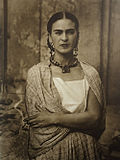Frida Kahlo
Magdalena Carmen Frida Kahlo y Calderón (6 July 1907 – 13 July 1954), Mexican Painter usually known as Frida Kahlo. She was known for her surreal and very personal works. She was married to Diego Rivera, also a well-known painter.
She was born in Coyoacán, Mexico to a German father and Mexican mother. She was close with her father from a very young age mainly due to him being a professional photographer. She had polio that left her disabled when she was 6 years old and some think that she may have had spina bifida (a birth defect affecting the development of part of the spine) as well. She studied medicine and was going to become a doctor. Because of a traffic accident in a tram at age 18 which badly injured her, she had periods of severe pain for the rest of her life. After this accident, Kahlo no longer continued her medical studies but took up painting. She used ideas about things that had happened to her. Her paintings are often shocking in the way they show pain and the harsh lives of women, especially her feelings about not being able to have children. Fifty-five of her 143 paintings are self-portraits. She was also influenced by native Mexican culture, shown in bright colors, with a mixture of realism and symbolism. Her paintings attracted the attention of the artist Diego Rivera, whom she later married. She was openly bisexual and was a communist.[1] She died of a pulmonary embolism caused by bronchopneumonia in Coyoacán.
Kahlo's work is sometimes called "surrealist", and although she organized art shows several times with European surrealists, she herself did not like that label. Her attention to female themes, and the honesty in her painting them, made her something of a feminist cult figure in the last decades of the 20th century. Some of her work is seen at the Frida Kahlo Museum, found in her birthplace and home in suburban Mexico City.
Frida Kahlo Media
Rivera, Kahlo, and Anson Goodyear
A portrait of Kahlo by Magda Pach, wife of Walter Pach, in the Smithsonian American Art Museum (1933)
Kahlo (on the right) and her sisters Cristina, Matilde, and Adriana, photographed by their father, 1916
Kahlo with husband Diego Rivera in 1932
Frida photographed in 1932 by her father, Guillermo
Related pages
References
- ↑ "Biography". Archived from the original on 2012-04-18. Retrieved 2012-04-26.








